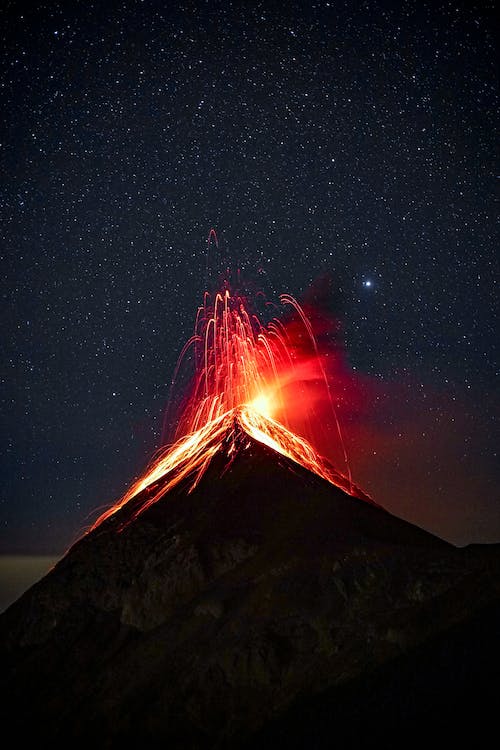For years, scientists have been trying to discover the process of a volcanic eruption. While the process itself is one thing, the lightning of volcanic eruption has had a lot of researchers wondering about how and why it takes place. Today, after countless studies and researches, scientists and researchers have come close to what lightens up volcanic eruptions.
Studies have also allowed scientists to measure how much ash a volcano is spewing out and also predict the air quality both during and after eruptions. Although much of the secret has finally been cracked, there are a lot of other things that make volcanic eruptions special. Let’s discuss.
What is Volcanic Lighting?
Volcanic eruptions produce an electrical discharge that is similar to an ordinary thunderstorm. Back in the day, it was thought that only thunderstorms and clouds could create an electric discharge. However, in the past few years, things have taken a slightly different turn. Today, it has been found the volcanic eruptions also produce an electric discharge.
Volcanic lighting takes place when fragmented particles of volcanic ash collide with each other. It might also be sometimes ice. The process leads to the generation of static electricity as well within the volcanic plume leading to what is also known as the dirty thunderstorm. In addition to that, ice formation and moist convention can also affect the eruption plume dynamics that can also trigger volcanic lightning. However, unlike thunderstorms, volcanic lightning can also occur before any ice crystals have formed in the ash clouds.
The first volcanic lightning was recorded and observed by Pliny the Younger at Mount Vesuvius in 79 AD. He stated that there was immense darkness along with a fitful gleam of torches obscured by the transient blaze of lighting. Following the discovery, several more observations were made by Professor Palmieri who observed the eruptions of 1858, 1861, 1858, and 1872. His observations also concluded that volcanic eruptions do produce lighting.
Charging Mechanisms
Ice Charging
One of the major reasons contributing to volcanic eruptions is ice charging. It has and continues to play an important role in several types of volcanic eruptions, especially those that rise above the freezing level or involve magma-water interaction. On the other hand, ordinary thunderstorms produce lightning through ice charging.
The process takes place when ice crystals collide and the water clouds become electrified. In addition to that, volcanic plumes can also carry abundant water while the water is sourced from magma. The water is basically vaporized from nearby sources such as lakes and glaciers. Several studies state that the water content in volcanic plumes is relatively greater than in thunderstorms.
Initially, the water is transported as a hot vapor, which then condenses to liquid in the rising column and ultimately freezes to ice if the plume happens to cool well below freezing. Moreover, some volcanic eruptions can also produce volcanic hail.
Frictional Charging
Volcanic eruptions are also known to give birth to frictional or triboelectric charging, which is thought to be a major electrical charging mechanism. Electrical charges take place when ash, rock fragments, and ice particles in a volcanic plume collide and produce static charges, very similar to the way ice particles collide in regular thunderstorms.
Radioactive Charging
Even though radioactive charging is thought to have a small effect on the overall charging of volcanic plumes but they do influence particle charging. Researchers who studied ash particles from two important eruptions found that both samples possessed natural radioactivity above the background level. However, the radioisotopes were unlikely the source of self-charging. Scientists also concluded that the potential for greater charging where the particle size is larger is bigger as well.
Little Known Facts About Thunderstorms
We all are aware of thunderstorms that usually produce frightening sounds and visuals. They are produced in cumulonimbus clouds that happen to be some of the biggest clouds in the atmosphere. These clouds have a base of around 300 meters and are 1km above the ground. However, they can also grow to a height of 10 to 20 kilometers.
In addition to that, the cumulonimbus clouds can also pack as much energy as 10 Hiroshima-sized atomic bombs. The clouds get this energy from the movement and circulation of warm air, known as convection. The process involves warm and humid air rising from the ground into the upper atmosphere. This is where the air cools, condenses, and falls to form the cloud. The process continues until more humid air rises and cools. This creates a cycle that causes the cloud to grow in size.
Apart from the frightening sounds and visuals, thunderstorms form quickly and can take as little as one hour to form. Thunderstorms happen to be common where the air is both hot and humid.
Little Known Facts About Lightning
The first most intriguing fact about lightning is its speed. A lightning strike travels at a speed of around 270,000 mph that is unbelievably fast. What it means is that it would take only 55 minutes to travel to the moon and around 1.5 seconds to get from London to Bristol. Furthermore, when lightning strikes sand or sandy soil, the fuses the grains together to create a small glass-like tube known as fulgurite. This phenomenon holds significant value in terms of scientific evidence and is prized by collectors as well.
If you were wondering above the most lightning-struck location in the world, then it is Lake Maracaibo in Venezuela that experiences around 140-160 lightning strikes per year with an average of 28 lightning strikes per minute lasting for up to 10 hours at a time.
Final Word
Although volcanic lightning is a commonly observed phenomenon in the world today but scientists continue to study the process to come up with in-depth knowledge and information. However, whatever information we have on volcanic eruptions and lightning allows us to predict when a volcanic eruption is going to take place along with its intensity.

